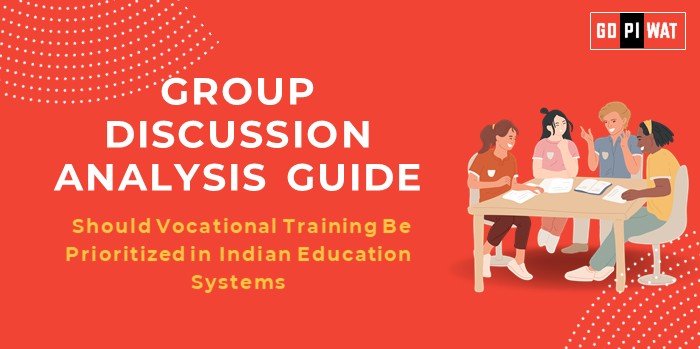📋 Should Vocational Training Be Prioritized in Indian Education Systems?
🌐 Group Discussion Analysis Guide
💡 Introduction to the Topic
Opening Context: “In a nation aspiring to be the world’s next manufacturing and service hub, vocational training emerges as a critical catalyst for employability and economic growth.”
Topic Background: India’s education system has traditionally emphasized academic knowledge over skill-based learning. With youth unemployment at 10.6% (2024) and industries facing a widening skill gap, integrating vocational training into education is an urgent need.
📊 Quick Facts and Key Statistics
- 📉 Youth Unemployment: 10.6% (2024), reflecting the urgent need for skill development.
- 🎓 Formal Skill Training: Only 4.7% of India’s workforce receives formal training compared to 52% in the US and 75% in Germany (ILO, 2023).
- 🛠️ Skill Gap Projection: By 2030, India will need an additional 90 million skilled workers (NSDC).
- 💡 Government Initiatives: PMKVY has trained 15 million youth since 2015, but 30% remain unemployed post-training.
🤝 Stakeholders and Their Roles
- 🏛️ Government: Develop policies and funding through initiatives like Skill India and PMKVY.
- 🏫 Educational Institutions: Integrate vocational modules into school and college curricula.
- 🏢 Industries: Collaborate for training programs and job placements.
- 👨🎓 Students: Adopt skill-based programs to enhance employability and career readiness.
- 🌍 International Organizations: Collaborate on standards, funding, and certification processes.
🏆 Achievements and ⚠️ Challenges
✨ Achievements:
- 📜 Policy Framework: NEP 2020 promotes vocational education from Grade 6 onwards.
- 🤝 Industry Partnerships: Successful programs like TCS iON and L&T vocational training initiatives.
- 👩🔧 Women Empowerment: PMKVY reports 40% female participation in skill-based training.
- 🌟 Global Benchmarks: Gujarat’s ITI program aligns with Germany’s successful dual vocational system.
⚠️ Challenges:
- ⚖️ Social Stigma: Vocational training is often viewed as inferior to mainstream education.
- 🏢 Infrastructure Gaps: Limited training centers and outdated equipment hinder quality learning.
- 💼 Placement Issues: There is often a mismatch between training outcomes and market needs.
Global Comparisons:
- 🇩🇪 Germany: 75% of the workforce is trained through a dual vocational system that combines theory with practical work.
- 🇰🇷 South Korea: Integration of technology in vocational education has yielded high employment rates.
Case Study:
🌟 Kerala Model: Comprehensive vocational training integrated with ITIs resulted in an 80% job placement rate in the manufacturing sector.
🗣️ Structured Arguments for Discussion
- Supporting Stance: “Prioritizing vocational training bridges the skill gap, aligning education with market demands.”
- Opposing Stance: “A strong focus on vocational training might undermine academic rigor and general education.”
- Balanced Perspective: “Vocational training complements academic learning, fostering holistic development while addressing employability gaps.”
💬 Effective Discussion Approaches
🔹 Opening Approaches:
- 📊 Statistical Insight: “Only 4.7% of India’s workforce receives formal skill training, compared to 52% in the US.”
- 🌟 Case Study: “Kerala’s ITI model achieved an 80% job placement rate in manufacturing industries.”
🔄 Counter-Argument Handling:
- ⚖️ Acknowledge social stigma but highlight success stories and government initiatives driving change.
- 🌍 Emphasize global benchmarks like Germany’s dual system to demonstrate vocational training’s value.
📊 SWOT Analysis
- 💪 Strengths:
- 🌍 Young and growing workforce.
- 📜 Supportive government policies like Skill India.
- 🔻 Weaknesses:
- 🏢 Limited infrastructure and resources.
- ⚠️ Societal bias against vocational education.
- 🚀 Opportunities:
- 💻 Technology-driven skill training programs.
- 🌍 Collaborations with global benchmarks and industries.
- ⚠️ Threats:
- 🛑 Resistance to change in traditional educational mindsets.
- 🤖 Rapid automation reducing low-skilled job opportunities.
📚 Connecting with B-School Applications
- 📊 Real-World Applications: Analyze case studies on skill development initiatives and CSR in education.
- 💼 Sample Interview Questions:
- “How can NEP 2020 redefine vocational training for India’s future workforce?”
- “Discuss the role of industries in bridging skill gaps through vocational education.”
- 💡 Insights for Students:
- Explore internships with organizations prioritizing vocational education.
- Research successful global models like Germany’s dual system for implementation insights.


